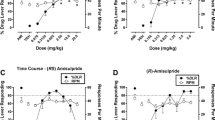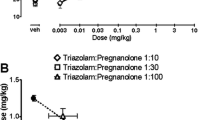Abstract
This study is concerned with dissecting out differences in the discriminative stimulus attributes between drugs from broader pharmacological categories such as sedative/hypnotics where generalization tests often indicate shared stimulus effects. To this end, the discriminative stimulus effects of three to five doses of either chlordiazepoxide (CDP), chlormethiazole (CMZ), ethanol (ETOH), and pentobarbital (P-barb) were studied with gerbils in a two-choice, T-maze task. When the discrimination was based upon the presence versus the absence of drug administration, speed of acquiring the discrimination increased dose-dependently for all four drugs with log of sessions to criterion being a linear function of log dose. The slopes of all four lines were similar. The acquisition of a discrimination based on different doses of the training drug was then examined. A two-to-one ratio of high to low doses was used. Discriminative control developed with CMZ, ETOH, and P-barb, but not with CDP. The side of the T-maze that correlated with the lower training dose was always selected in tests with saline. Gerbils were then trained to discriminate between two drugs using at least two different dose combinations. The CDP versus CMZ, CDP versus ETOH, CMZ versus P-barb, CMZ versus ETOH discriminations were acquired. The CDP versus P-barb discrimination was obtained across doses only after an additional training procedure was instituted such that the P-barb dose was incremented gradually from low to higher doses during discrimination training; the CDP training doses were 20 and 30 mg/kg in two different groups of gerbils, respectively and the dose of P-barb was incremented by 2.5 mg/kg until the final dose of 20 mg/kg was reached with the barbiturate. Thus, although often shown to share similar stimulus effects, members of the broad pharmacological class of CNS sedatives/hypnotics nonetheless were shown to be discriminable from one another. Non-drug tests (vehicle) were used to assess stimulus control between pairs of drugs, equal control being implicated when responding was evenly distributed across the two training conditions.
Similar content being viewed by others
Author information
Authors and Affiliations
Additional information
Received: 28 May 1997 / Final version: 11 July 1997
Rights and permissions
About this article
Cite this article
Järbe, T., Swedberg, M. Discriminative stimulus functions of CNS sedative drugs assessed by drug versus drug discrimination procedures in gerbils. Psychopharmacology 135, 201–212 (1998). https://doi.org/10.1007/s002130050502
Issue Date:
DOI: https://doi.org/10.1007/s002130050502




